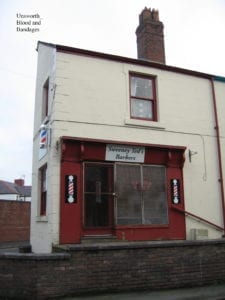Patricia A. Unsworth
Bolton, England, United Kingdom

The notorious Sweeney Todd, the demon barber of Fleet Street, is possibly the first thought that comes to mind at the mention of barber surgeons, but how far from reality was this character of Victorian fiction? Perhaps not so far removed as one might imagine.
Todd was obviously a barber, a cutter of hair and shaver of chins, and he had also some skill of the surgeons of the time in his ability to butcher his victims into the required cuts of meat for Mrs. Lovett’s pies. However, by this time the barbers and the surgeons were, for the most part, different entities. It takes a long look back into history to discover how the two parties became one and, in more recent times, how the practices diverged into two once more.
The first known barber surgeons appeared in the Middle Ages working in the monasteries. Primarily, their role was to shave the monks, in particular ensuring the baldness of the tonsure, but having the requisite tools, they also practiced dentistry, bloodletting, and simple surgery.
Physicians, the university educated doctors, did not practice surgery. They had a purely academic approach to medicine and their degree of Doctor of Medicine included no practical training. In contrast, barber surgeons learned their trade as apprentices and, like the apprentices of today, took an examination at the end of their training and received a diploma. Whereas the physicians shed no blood, the barber surgeons approach was definitely hands-on.
More notably, the barber surgeons practiced their trade in France and England and the laws passed about their trade were enforced in these countries. Founded in 1210, The College of Surgeons at St. Come in Paris separated the master surgeons from the apprentices and distinguished themselves by the length of their robes. The long robes were worn by the master surgeons and the short robes by the apprentices, the barbers.
In 1371 the French king, Charles V, proclaimed his own barber the head of all French barbers and surgeons. Before this, in 1308, King Edward II of England had granted the barbers their guild and in 1375 the guild was separated into surgeons and barbers. The barbers belonged to the Company of Barbers, which sported a much larger membership than the Fellowship of Surgeons and there was a distinct difference between these guilds: barbers cut hair, drew teeth, dealt with minor wounds, set bones, applied poultices, and other non-invasive medical practices, whereas the more competent surgeons performed the skilled procedures of trepanation, amputation, cauterization, and so on.
Almost two centuries later in 1540, Henry VIII created the United Barber Surgeons Company and, with the joining of the guilds, the skills, as the title implies, were also amalgamated into the persons of the barber surgeons.
Yet again, two centuries later, terms for the barbers were changed. In 1743 in France barbers were banned from practicing surgery. Two years later in England the guilds were divided once more when King George II established the London College of Surgeons and the job of a surgeon was viewed no longer as a trade but a profession. The Company of Barbers remained, but gradually the medical role of the barbers dwindled.
From their medieval beginnings the services of the barbers increased, and their need was never greater than during the thirteenth and fourteenth centuries when the plague, the Black Death, hit Europe. Known as the Flying Barbers, the barber surgeons traveled from town to town, setting up camps on the outskirts and holding surgeries where their attempted cures mainly consisted of bloodletting. Probably they did more harm than good, but there was no one else for the people to turn to.
At this time, the barber surgeons still practiced the medieval system of medicine based on the four humors—phlegm, blood, yellow bile, and black bile. Any sickness was attributed to an imbalance of these humors and the barber surgeons would compare a urine sample against a urine chart to diagnose the cause of illness and thence decide from which part of the body to draw blood.

The treatment of bloodletting, using leeches, was to re-establish the balance of the humors. Even into the nineteenth century, bloodletting remained popular as a cure for many ailments. Leeches were the means of drawing blood, but as the availability of leeches declined due to overuse, the barber surgeon attained the ability to extract blood from a vein.
Trepanation, the art of drilling a small hole in the skull to just above the membrane surrounding the brain, was also common practice. Initially it was believed that this would allow the demon inflicting the patient to escape. This procedure of trepanation was used on patients with epilepsy and conditions recognized today such as autism. As with bloodletting, trepanation caused more harm than good and was certainly no cure.
During the centuries that followed the Black Death, the skills of the barbers and surgeons were regarded for a long time as much the same, but despite the amalgamation of the guilds in 1540 and as medical knowledge increased, the two entities were beginning to establish themselves as separate professions. One of the prime movers in the separation was the sixteenth century French surgeon, Ambroise Pare.
Trained as an apprentice barber surgeon, Pare spent most of his career as a military surgeon, but during his field work his progressive methods set the basis for much of today’s surgery. He developed his own sealant for cauterizing wounds and for more serious amputations the use of ligatures. As he lived through the era which introduced the use of firearms into battle situations, Pare was obliged to deal with more serious wounds. His success allowed him to write books on anatomy and the treatment of wounds.
Nowadays there is no apparent link between the barbers and surgeons. Or is there? With more unisex hairdressing establishments, the number of traditional barber’s shops is not as prolific as it once was, yet outside some of these remaining shops can still be seen the barber’s pole. Red and white stripes symbolize the blood and bandages of this lost trade. The blood was that taken during bloodletting and the bandages were those used to mop up the blood. The pole itself was gripped by patients during this unpleasant procedure.
In another link with the past, a present day surgeon in England is not known by the title Doctor, but by Mr., harking back to when surgeons were not considered qualified to be doctors of medicine.
As barbaric and lacking in knowledge as were the medical practices of these barber surgeons, they were, in fact, at the beginnings of the advancement in medicine. Unlike the physicians of their time, the barber surgeons, through their hands-on approach to ailments and the innovations this brought about, gradually found means of improving the lot of patients.
PATRICIA A. UNSWORTH has worked in different industries, but her writing experience has taught her that research and human nature are her forte.
Submitted for the 2019–2020 Blood Writing Contest & Highlighted in Frontispiece Volume 12, Issue 2 – Spring 2020

Leave a Reply